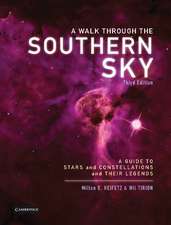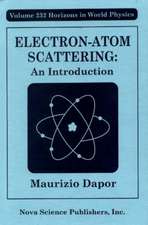Atoms and Molecules Interacting with Light: Atomic Physics for the Laser Era
Autor Peter van der Straten, Harold Metcalfen Limba Engleză Hardback – 3 feb 2016
Preț: 453.88 lei
Preț vechi: 509.99 lei
-11% Nou
Puncte Express: 681
Preț estimativ în valută:
86.86€ • 94.32$ • 72.96£
86.86€ • 94.32$ • 72.96£
Carte tipărită la comandă
Livrare economică 22 aprilie-06 mai
Preluare comenzi: 021 569.72.76
Specificații
ISBN-13: 9781107090149
ISBN-10: 1107090148
Pagini: 527
Ilustrații: 160 b/w illus. 31 tables
Dimensiuni: 180 x 253 x 27 mm
Greutate: 1.4 kg
Editura: Cambridge University Press
Colecția Cambridge University Press
Locul publicării:New York, United States
ISBN-10: 1107090148
Pagini: 527
Ilustrații: 160 b/w illus. 31 tables
Dimensiuni: 180 x 253 x 27 mm
Greutate: 1.4 kg
Editura: Cambridge University Press
Colecția Cambridge University Press
Locul publicării:New York, United States
Cuprins
Part I. Atom-Light Interaction: 1. The classical physics pathway; Appendix 1A. Damping force on an accelerating charge; Appendix 1B. Hanle effect; Appendix 1C. Optical tweezers; 2. Interaction of two-level atoms and light; Appendix 2A. Pauli matrices for motion of the bloch vector; Appendix 2B. The Ramsey method; Appendix 2C. Echoes and interferometry; Appendix 2D. Adiabatic rapid passage; Appendix 2E Superposition and entanglement; 3. The atom-light interaction; Appendix 3A. Proof of the oscillator strength theorem; Appendix 3B. Electromagnetic fields; Appendix 3C. The dipole approximation; Appendix 3D. Time resolved fluorescence from multi-level atoms; 4. 'Forbidden' transitions; Appendix 4A. Higher order approximations; 5. Spontaneous emission; Appendix 5A. The quantum mechanical harmonic oscillator; Appendix 5B. Field quantization; Appendix 5C. Alternative theories to QED; 6. The density matrix; Appendix 6A. The Liouville–von Neumann equation; Part II. Internal Structure: 7. The hydrogen atom; Appendix 7A. Center-of-mass motion; Appendix 7B. Coordinate systems; Appendix 7C. Commuting operators; Appendix 7D. Matrix elements of the radial wavefunctions; 8. Fine structure; Appendix 8A. The Sommerfeld fine-structure constant; Appendix 8B. Measurements of the fine structure 9. Effects of the nucleus; Appendix 9A. Interacting magnetic dipoles; Appendix 9B. Hyperfine structure for two spin =2 particles; Appendix 9C. The hydrogen maser; 10. The alkali-metal atoms; Appendix 10A. Quantum defects for the alkalis; Appendix 10B. Numerov method; 11. Atoms in magnetic fields; Appendix 11A. The ground state of atomic hydrogen; Appendix 11B. Positronium; Appendix 11C. The non-crossing theorem; Appendix 11D. Passage through an anticrossing: Landau–Zener transitions; 12. Atoms in electric fields; 13. Rydberg atoms; 14. The helium atom; Appendix 14A. Variational calculations; Appendix 14B. Detail on the variational calculations of the ground state; 15. The periodic system of the elements; Appendix 15A. Paramagnetism; Appendix 15B. The color of gold; 16. Molecules; Appendix 16A. Morse potential; 17. Binding in the hydrogen molecule; Appendix 17A. Confocal elliptical coordinates; Appendix 17B. One-electron two-center integrals; Appendix 17C. Electron-electron interaction in molecular hydrogen; 18. Ultra-cold chemistry; Part III. Applications: 19. Optical forces and laser cooling; 20. Confinement of neutral atoms; 21. Bose–Einstein condensation; Appendix 21A. Distribution functions; Appendix 21B. Density of states; 22. Cold molecules; 23. Three level systems; Appendix 23A. General case for _1 , _2; 24. Fundamental physics; Part IV. Appendices: Appendix A. Notation and definitions; Appendix B. Units and notation; Appendix C. Angular momentum in quantum mechanics; Appendix D. Transition strengths; References; Index.
Recenzii
'Two experienced pedagogues and researchers on laser cooling and trapping and quantum hydrodynamics have written a rigorous textbook for advanced undergraduates and graduate students. The work provides a comprehensive description of the fundamentals and of the awe-inspiring recent advances in atomic and molecular physics, such as the theory and the experimental techniques of Bose–Einstein condensation, laser cooling, and optical lattices. The authors point out common misconceptions in atomic physics, e.g. about 'virtual states', resonances, and the vector potential. Each chapter is augmented with supplementary materials and exercises which assess comprehension and further the understanding of the content. … Detailed tables and plots of experimental data permit the numerical calculation of physical parameters. The exact quantum mechanical solutions to a few physical problems are derived as well as the various useful approximations for atoms and molecules, and their limitations are clearly explained.' Barry R. Masters, Optics and Photonics News
Notă biografică
Descriere
Focusing on atom-light interactions and containing numerous exercises, this in-depth textbook prepares students for research in a fast-growing field.















